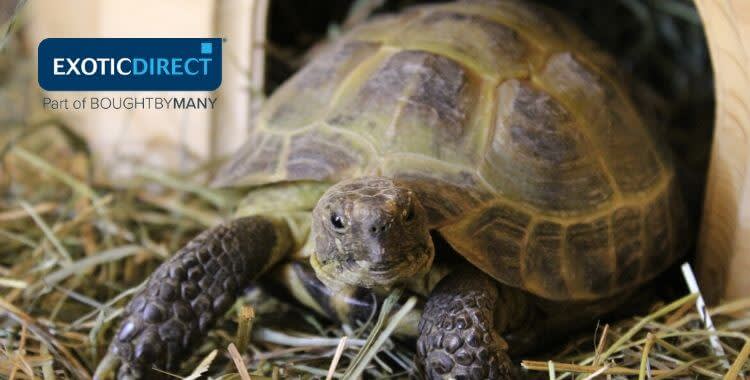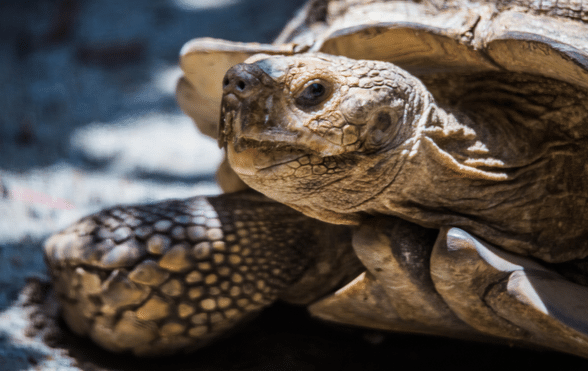A discharge from the nostrils provides the best indication of a respiratory infection in the early stages. The tortoise will usually appear healthy and be eating well.
Is your tortoise insured? Get a quote for £2,500 of vet fees, death and theft cover. Vet fee cover only also available | We’ve been insuring exotic pets since 1996 | Check out our customer reviews on Feefo.
Respiratory infections in tortoises are not uncommon and can often be linked with unsuitable environmental conditions. They are also serious, requiring urgent veterinary investigation because of the structure of the tortoise’s body.
Don’t be tempted to treat the infection yourself at home, in the hope it will clear up. Your tortoise will need to see a vet. You can find a vet here.
Tortoise respiratory infection symptoms
The danger is that at first your tortoise may not show any significant signs of illness.
Early symptoms will include a runny nose, usually with a clear nasal discharge from the nostrils.
On occasion this may form small bubbles at the nostrils accompanied by noisy breathing although the discharge may quickly become thicker and yellowish.
There can also be an accompanying discharge from the eyes, accompanied by swelling in this area, although this may not be obvious.
At this point your tortoise may not show any other serious signs of illness, although its appetite is likely to be reduced, and it will be less active than usual.
What can happen quite quickly is that the upper respiratory tract infection spreads down into the lungs, giving rise to pneumonia.
The symptoms will then become more evident as the tortoise’s pattern of breathing becomes more laboured.
It will move its head around, appearing distressed and extending its neck abnormally as it tries to clear the mucus accumulating in its lungs. It will tend to keep its mouth open at this stage, as a means of trying to breathe.
The tortoise’s condition will rapidly start to weaken, and it will rest with its head on the ground. By this stage, the tortoise will have lost its appetite and is unlikely to be moving around, staying in one place in its enclosure.

A discharge from the nostrils provides the best indication of a respiratory infection in the early stages. This tortoise appears healthy and is eating well.
Jump to: Are tortoise respiratory infections serious? | Types of respiratory infection | Causes of respiratory infection | Diagnosis of respiratory infection | Treatment | Recovery time | Tortoises more prone to infections
Are tortoise respiratory infections serious?
Yes, tortoise respiratory infections are very serious. This is because of the anatomy of the tortoise’s respiratory tract.
Chelonians (meaning all tortoises, terrapins and turtles) do not have a diaphragm which serves as a partition between the chest and abdomen.
This means that any mucus that forms cannot be coughed up out of the lungs but accumulates there, seriously compromising the functioning of the lungs.
In addition, tortoises also lack the minute hair-like structures called cilia in their lungs, which act rather like brushes, helping to remove mucus from the airways.
If you suspect that your tortoise has a respiratory infection then it is very important to consult a specialist reptile vet without delay. This will greatly enhance the chances of a successful recovery.
You should also isolate the infected tortoise from other tortoises you may own. This can help prevent the spread of infection.
Cleaning your tortoise’s enclosure thoroughly using a reptile-safe disinfectant is also very important.
Types of respiratory infection in tortoises
Respiratory infections in tortoises can be grouped into upper respiratory tract infections, where the most obvious symptom is a runny nose (known as ‘rhinitis’), accounting for the name of Runny Nose Syndrome (frequently abbreviated to RNS).
There is also the risk of a lower respiratory tract infection, defined by pneumonia, which is usually triggered following an upper respiratory tract infection and is life-threatening.

Hay can be full of potentially harmful fungal spores that can be inhaled into the lungs. It is not recommended as tortoise bedding for this reason
Causes of respiratory infections
It is not easy to determine what type of microbe is affecting a tortoise showing signs of respiratory distress, and often there may be more than one type involved.
Mycoplasma
Tortoises can carry potentially harmful microbes, notably Mycoplasma bacteria within their nasal chambers. These typically will not cause disease under normal circumstances as they are kept in check by the body’s immune system.
If environmental conditions are less than ideal however, then symptoms will develop and the infection can rapidly lead to the tortoise’s demise.
Typical triggers of this type, especially in tropical tortoises which do not hibernate, are likely to include; a fall in environmental temperature resulting in the tortoise becoming chilled; longer term exposure to a sub-optimal temperature and/or a dietary deficiencies, especially of Vitamin A.
The tortoise’s environment is vital in terms of preventing respiratory disease.
Bedding
Hay, which can be full of potentially harmful fungal spores that can be inhaled into the lungs, is not recommended as bedding. This is because the fungus can also give rise to respiratory infection.
Post hibernation
In species which do hibernate, the risk of respiratory infection is greatest after they emerge from hibernation, especially if they are suffering from ‘mouth rot’ or stomatitis. This is because of the link between the mouth, throat and the nasal passages. Learn more about caring for your tortoise as it emerges from hibernation here.
Environmental temperatures
Later in the year if a tortoise is left outside during a wet, chilly summer, the adverse weather can also trigger a respiratory infection, as the tortoise’s immune system is more vulnerable under such conditions. Learn how to care for your tortoise outside.
Equally indoors, too dry an atmosphere in the tortoise’s quarters and dusty bedding could be implicated as triggers. Learn what setup you need for a tortoise.
How is a tortoise respiratory infection diagnosed?
Clinical signs often point towards a diagnosis, but discovering a precise cause requires laboratory work.
A wide range of different bacteria have been isolated and identified as potential causes of upper respiratory disease in tortoises.
Distinguishing between them may be significant in terms of giving the best treatment, and so swabs may be taken for this purpose.
If the underlying cause is viral in origin, this can be determined by a laboratory PCR test. But just to complicate the position, more than one class of infectious microbe may be involved, with viral, bacterial and fungal components.
Where a reptile herpes virus is involved the symptoms may extend beyond the respiratory tract, tending to affect the mouth as well. These offer diagnosis clues for your vet.
How is a tortoise respiratory infection treated?
The first step will be for your vet to carry out tests to determine the precise cause of the illness and to determine if there are any steps you can take to improve your tortoise’s care.
Being able to establish the cause means that it will be easier to treat the condition successfully.
Antibiotics will be used if it’s a bacterial infection, and anti-fungal and anti-viral drugs are also available.
The prescribed treatment will need to be combined with any recommended changes in the tortoise’s environment or care, as advised by your vet.
Typically, it can be useful to raise the temperature of a sick tortoise’s environment slightly, as this will serve to assist its natural body defences to fight the infection more effectively.
Your vet may administer an antibiotic via injection to counteract the infection, and you may need to give nasal drops to your tortoises as well.
Nursing care, such as wiping away any nasal discharge is important too. This is because blocked nostrils will mean the tortoise is less likely to eat, therefore setting back recovery.
How long will it take to recover?
Although you should notice a gradual improvement within a few days, and your tortoise should be back to normal within a couple of weeks, the outlook will be unclear In the longer term.
There is no guarantee that treatment will eliminate the causal bacterium totally.
Firstly, there is a risk that the infection may return in the future, and secondly, that the tortoise will represent a hazard to other tortoises it comes into contact with afterwards.
Follow-up screening may help give some clues, but this cannot be guaranteed.
Which tortoises are most prone to respiratory infections?
The list below shows most at risk tortoises:
- Leopard tortoise (Stigmochelys pardalis)
- Mediterranean spur-thighed tortoise (Testudo gracea)
- Hermann’s tortoise (Testudo hermanni)
- American gopher tortoise (Gopherus species)
Other causes of noisy breathing and squeaking in tortoises
Noisy breathing may not only be the result of infection but can also be triggered by any obstruction affecting the upper respiratory tract.
This can often arise as the result of mucus accumulating here during hibernation.
Pick up your pet when it wakes and look closely at the nostrils as they may have become partly blocked.
The condition should improve once you place your pet in a shallow bath of warm water as a means of rehydration after its winter sleep.
Tortoises will often flush their nasal passages at this stage, jetting water out through their nostrils to clear any minor obstructions. This in turn will help to reduce the likelihood of a respiratory infection developing.
Noisy breathing can also be linked to an obstruction affecting the nostrils, linked to the tortoise’s food.
This is especially common in the case of tortoises such as the red-footed (Chelonoidis carbonarius) which feed partly on fruit, as pieces of soft fruit can become stuck over the nostrils it feeds. These deposits are then likely to dry there.
The same can apply when tortoises are eating moist pellets.
On occasions, foreign material gaining access to the nasal cavity can be a cause too, although this is unusual.
Fine grains of sand can have this effect and this is a reason why reptile sand shouldn’t be used as bedding for tortoises, as it can enter the nose cavity, causing irritation and discharge. This in turn can trigger an infection.
The significance of nostril size
Always look carefully at the nostrils of any tortoise that you are thinking of acquiring as this will give insights into its health. In older tortoises, if one of the nostrils is much larger than another, or both appear abnormally enlarged, this is usually a sign of a long-standing nasal infection.
And finally….
You should regularly spend a few moments daily observing your pet to see if it is making any strange noises when breathing. These often sound like a high-pitched whistle or even a squeak.
Getting to know your tortoise really well, and understand its habits and behaviour will help you to identify any changes. And any potential health problems.
Is your tortoise insured? Get a quote for £2,500 of vet fees, death and theft cover. Vet fee cover only also available | We’ve been insuring exotic pets since 1996 | Check out our customer reviews on Feefo.

